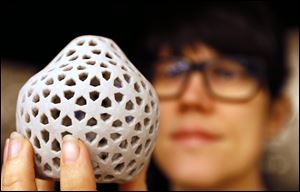
Edible-insect businesses working out the bugs
Gross-out factor can top lure of protein-rich food
8/10/2014
Designer Penelope Kupfer displays a biscuit made from insect flour at the Wellcome Collection in London.
In October, 2012, Megan Miller walked out of a San Francisco pet store carrying a bag filled with mealworms squirming in soil. When she arrived at her apartment, she took them straight to her kitchen.
Since mealworms take on the flavor of whatever they’ve been eating, soil included, Ms. Miller plucked them from the dirt and placed them in a bowl of oats and apples and let them munch for several days.
Then, following instructions she had found on the Internet, she blanched the worms in boiling water, roasted them, and plopped them into her blender along with dried plums, cinnamon, coconut oil, and banana. She shaped them into bars and chilled them in the refrigerator. Soon, she experimented with live crickets as well.
“I really had to buck up,” she said. “There are, like, thousands of insects crawling over one another.”
Ms. Miller had tasted crickets and mealworms during trips to Mexico and Southeast Asia, but this was her first foray into insect cooking. It was not to be her last.
The next summer, she founded a company, Chirp Farms, with a business partner; they split after several months when he became more interested in raising crickets than baking them.
In December, Ms. Miller left her job as the head of research and development for Bonnier AB, a global media company, and began working full time in the fledgling field of insect gastronomy. Along with two partners, Leslie Ziegler and Eric Woods, she founded Bitty Foods, a company that mills crickets and blends them with cassava and coconut. The result is a flour that the company sells online, along with cookies baked with the flour.
Ms. Miller and other American entrepreneurs in this field believe protein-rich insects, and crickets in particular, are poised to ignite a quinoa-like food craze.
One cup of Bitty Foods’ cricket flour contains 28 grams of protein, and Ms. Miller believes it could replace wheat flour in everything from pasta to bread to cake.
“My vision is that we’re going to boost the protein content of all the staple foods that we eat,” she says. “And we’re going to need a really sustainable and plentiful protein source to do that with.”
Ms. Miller and other edible-insect entrepreneurs also think crickets could appeal to people concerned with environmental sustainability. The insects take just six to eight weeks to reach maturity and, because they don’t require much food, water, or land and produce low levels of greenhouse gas emissions, they have a smaller carbon footprint than, say, a cow.
A 2013 report by the U.N. Food and Agriculture Organization that extolled insects’ potential to help stabilize the global food supply helped propel the edible-insect industry forward.
After the report came out, “all of a sudden there were a ton of people who were superinterested in edible bugs,” said Kevin Bachhuber, who in May started Big Cricket Farms in Youngstown. His farm is devoted exclusively to raising food-grade crickets for humans. He follows more stringent sanitation procedures and uses higher-quality feed grains than do farms that provide crickets sold at pet stores to feed lizards.
To get his business off the ground, Mr. Bachhuber called on Tiny Farms, a San Francisco edible-insect consulting company that assisted him with insect breeding, entomological research, and expense modeling.
Mr. Bachhuber’s 5,000-square-foot warehouse can produce 50,000 pounds of crickets per month. Inquiries have come from professional chefs, curious home cooks, and nongovernmental organizations interested in mixing crickets into their packaged MREs, or meals ready to eat.
For now, crickets and cricket flour are still relatively expensive. Mr. Bachhuber sells his crickets, which he ships frozen to customers, for $4.50 to $9 per pound.
One cup of Bitty Foods’ cricket flour requires about 4,000 crickets, according to Ms. Miller. The retail price for a 20-ounce bag of her cricket flour is $20. By comparison, a bag of regular all-purpose flour typically costs around $1 per pound in grocery stores. Ms. Miller thinks that when crickets are more widely available for purchase, the price could drop.
Bitty Foods sells several hundred bags of cookies each week through its Web site, according to Ms. Miller. In March, after giving a presentation at the TEDxManhattan conference, she got the attention of the Florence Group, a business that celebrity chef Tyler Florence helped found.
Mr. Florence’s company sells its California Crush wine at Target and is developing product lines for Williams-Sonoma and Costco, in addition to serving as an incubator for culinary start-ups.
Two weeks ago, the Florence Group, in the San Francisco Bay Area, became an equity investor in Bitty Foods. “It tastes like dark toast,” Mr. Florence says of cricket flour. The plan is for Mr. Florence and Ms. Miller to fine-tune Bitty Foods’ flour and use it as a staple for the other products they create, which Mr. Florence says will “feel really familiar but most importantly will taste delicious.”
Cricket-flour pasta or muffins will have to be very appetizing to overcome Americans’ revulsion of eating insects, even cute ones such as crickets. “Obviously there’s the gross factor, so you run the risk that no one’s going to buy it,” according to Kelly Goldsmith, assistant professor of marketing at Northwestern University’s Kellogg School of Management.
“If you get just regular diners who are not foodies and not gluten-free to try these cookies, and they don’t taste great,” Ms. Goldsmith warns, “there will not be a repeat purchase.”